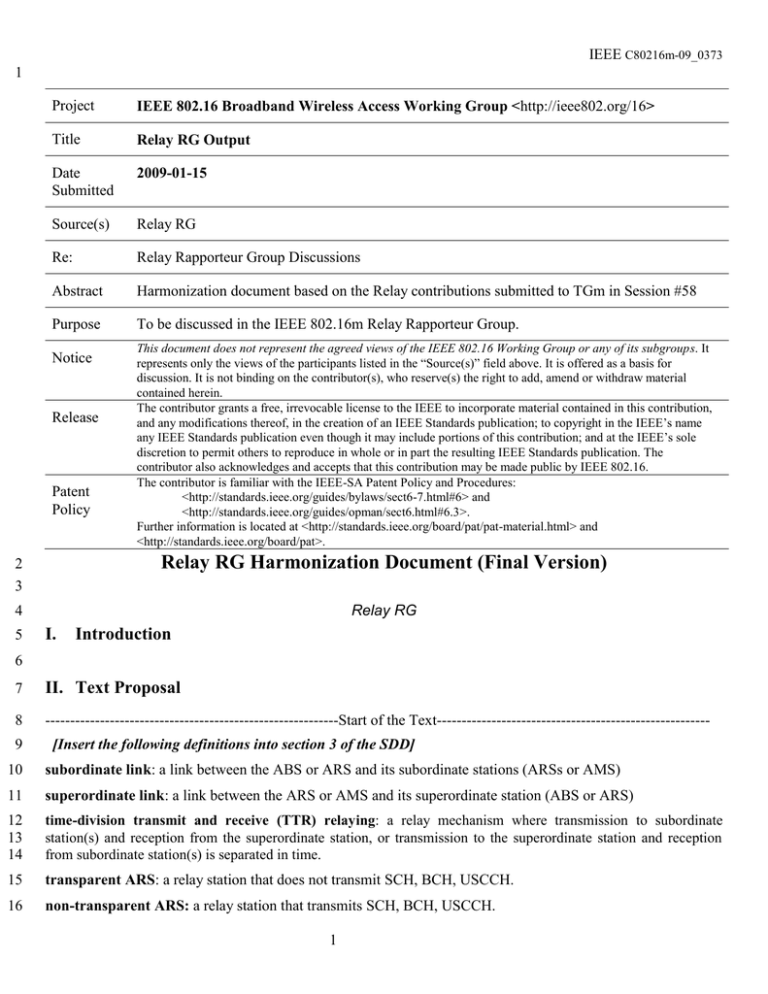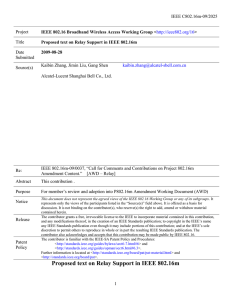IEEE 1 Project
advertisement

IEEE C80216m-09_0373 1 Project IEEE 802.16 Broadband Wireless Access Working Group <http://ieee802.org/16> Title Relay RG Output Date Submitted 2009-01-15 Source(s) Relay RG Re: Relay Rapporteur Group Discussions Abstract Harmonization document based on the Relay contributions submitted to TGm in Session #58 Purpose To be discussed in the IEEE 802.16m Relay Rapporteur Group. Notice Release Patent Policy This document does not represent the agreed views of the IEEE 802.16 Working Group or any of its subgroups. It represents only the views of the participants listed in the “Source(s)” field above. It is offered as a basis for discussion. It is not binding on the contributor(s), who reserve(s) the right to add, amend or withdraw material contained herein. The contributor grants a free, irrevocable license to the IEEE to incorporate material contained in this contribution, and any modifications thereof, in the creation of an IEEE Standards publication; to copyright in the IEEE’s name any IEEE Standards publication even though it may include portions of this contribution; and at the IEEE’s sole discretion to permit others to reproduce in whole or in part the resulting IEEE Standards publication. The contributor also acknowledges and accepts that this contribution may be made public by IEEE 802.16. The contributor is familiar with the IEEE-SA Patent Policy and Procedures: <http://standards.ieee.org/guides/bylaws/sect6-7.html#6> and <http://standards.ieee.org/guides/opman/sect6.html#6.3>. Further information is located at <http://standards.ieee.org/board/pat/pat-material.html> and <http://standards.ieee.org/board/pat>. 2 3 Relay RG Harmonization Document (Final Version) 4 Relay RG 5 I. Introduction 6 7 II. Text Proposal 8 -----------------------------------------------------------Start of the Text------------------------------------------------------- 9 [Insert the following definitions into section 3 of the SDD] 10 subordinate link: a link between the ABS or ARS and its subordinate stations (ARSs or AMS) 11 superordinate link: a link between the ARS or AMS and its superordinate station (ABS or ARS) 12 13 14 time-division transmit and receive (TTR) relaying: a relay mechanism where transmission to subordinate station(s) and reception from the superordinate station, or transmission to the superordinate station and reception from subordinate station(s) is separated in time. 15 transparent ARS: a relay station that does not transmit SCH, BCH, USCCH. 16 non-transparent ARS: a relay station that transmits SCH, BCH, USCCH. 1 1 IEEE C80216m-09_0373 access station: A station (ARS or ABS) that provides a point of access into the network for an AMS or ARS. 2 access ARS: A relay station which serves as an access station. 3 4 centralized security mode: This mode is based on authentication and key management between AMS and ABS, without involving the access ARS. 5 6 distributed security mode: This mode is based on authentication and key management between AMS and an access ARS, and between the access ARS and the ABS. 7 8 [Insert the following text into section 15 of the SDD] 9 15 Relay 10 15.1 Relay Model 11 12 Relay models capture the modes of operation supported in relay based on the frame structure and the access station perspectives. 13 Relaying in the Advance WirelessMAN-OFDMA System is performed using a decode and forward paradigm. 14 15 In Advance WirelessMAN-OFDMA System, the ABS and ARSs deployed within a sector operate using either time division duplexing (TDD) or frequency division duplexing (FDD) of DL and UL transmissions. 16 An ARS operates in TTR mode. 17 18 19 ARSs may operate in transparent or non-transparent mode. Transparent relay is limited to the case where the superordinate station is a non-transparent ARS or an ABS. The ABS can support the co-existence of the transparent and the non-transparent ARSs. 20 21 22 ARSs may operate as part of a Transparent ARS group, in which case a group of transparent ARSs work with a superordinate station (a nontransparent ARS or ABS) to appear as a single base station to AMSs by forwarding data and messages from the superordinate station to the AMSs (and vice versa). 23 24 25 26 27 28 29 30 31 ARSs may perform local forwarding between AMSs attached to ARSs controlled by the same ABS. In local forwarding mode, data sent between AMSs is forwarded without being sent to the BS. 32 33 ARS may transmit data to the super-ordinate and sub-ordinate station(s) using the same LRU (e.g., MIMO, network coding, etc) Cooperative relaying is a technique whereby either the ABS and one or more ARSs, or multiple ARSs cooperatively transmit or receive data to/from one subordinate station or multiple subordinate stations. Cooperative relaying may also enable multiple transmitting/receiving stations to partner in sharing their antennas to create a virtual antenna array, allowing the extraction of multiple-input multiple-output (MIMO) system benefits such as transmit/receive diversity, spatial multiplexing and beamforming gains (i.e., power efficiency) from the wireless channel in a distributed fashion. 34 35 15.2 Scheduling Model 36 An ARS operates in distributed or centralized scheduling. 37 38 39 When an ABS is configured to operate in centralized scheduling, each ARS attached to the ABS is configured as a non-scheduling ARS. A non-scheduling ARS is an ARS that does not schedule any radio resource. The ABS schedules all radio resources in its cell and ARSs do not schedule any radio resource. 40 2 1 2 3 IEEE C80216m-09_0373 When an ABS is configured to operate in distributed scheduling, each ARS attached to the ABS is configured as a scheduling ARS, where a scheduling ARS is an ARS that is configured to schedule the radio resources of its subordinate links, each station (ABS or ARS) schedules the radio resources on its subordinate link. 4 5 15.3 Security Model 6 Security mode could be centralized or distributed security. 7 8 15.4 Data and Control Functions 9 -----------------------------------------------------------End of the Text-------------------------------------------------------- 10 11 References [1] IEEE C802.16m-08/003r5, “Project 802.16m System Description Document (SDD)”. 12 [2] IEEE C80216m-08/1498, “Session 58 Relay Rapp Group Report”. 13 3


